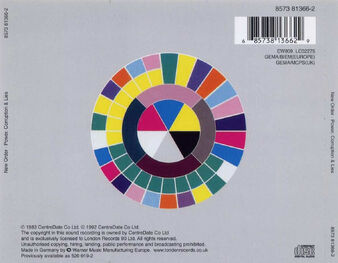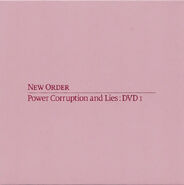Power, Corruption & Lies is the second album made by New Order. It was released 2 May 1983 with Factory Records. The first song off it, "Age of Consent", is considered one of the best New Order songs of all time. Its FAC number is 75, solidifying the pattern of New Order albums having releases that are multiples of 25. On CD and cassette releases, it contains the single "Blue Monday" and its B-side "The Beach".
Background
Title
After making songs such as Temptation, Everything's Gone Green, and Video 586, New Order thought it was about time to make a full album full of the synthpop and alternative dance they invented. While recording said album they thought of some titles for their album, like "How Does It Feel?" (referencing to Blue Monday) and "Piss Off You Shitheads" (referencing to Your Silent Face). Bernard Sumner then remembered a conceptual art exhibition in Germany he attended to in 1981 when artist Gerard Richter spray painted "Power, Corruption and Lies", on the outside of the Kunsthalle building. While Stephen Morris remembers the title as a quote on the back cover of a copy of George Orwell's Animal Farm,
Front Cover
To go with the title, Peter Saville, the designer for all previous, and most subsequent, New Order releases, figured he needed the portrait of a dark and renaissance-styled prince, but this was only because he was watching The Borgias at the time. He failed to find the perfect one. While going to the National Gallery in London with his girlfriend (name unknown), he found a postcard featuring the painting "A Basket of Roses" by Henri Fantin-Latour. His girlfriend joked that he should use this as his cover.
However, the owner of the copyrights for the painting, National Gallery, refused to let Factory Records have it. Tony Wilson, head of Factory Records, went to the gallery director and had a memorable talk with him. The gallery director made an exception and allowed Factory Records the picture. Peter Saville then put his code on the top corner, which reads "FACT 75", and the front cover was done.
Back cover

Back cover with Saville's code
Peter Saville also designed the back cover, it features the Saville Code formatted as a wheel. This symbol, and the code itself, is later prominently used in the lyric video for Blue Monday.
Reviews and Legacy
The album has been placed on Rolling Stones 100 greatest albums of the 1980's at #94 considered "a landmark album of danceable post-punk music." (the genre "alternative dance" was not coined yet). A bonus track was made on 2008 for Record Day.
Allmusic's John Bush has given the album 4 and a half stars with this review: "A great leap forward from their understandably funereal debut album, Power, Corruption & Lies cemented New Order's place as the most exciting dance-rock hybrid in music (and it didn't even include the massive "Blue Monday" single, released earlier that year). Confident and invigorating where Movement had sounded disconsolate and lost, the record simply pops with energy from the start. "Age of Consent," a shimmering pop song with only a smattering of synthesizers overlaying Bernard Sumner's yearning vocals, proved his most assured performance yet. Unlike most of their synth pop compatriots, New Order not only utilized a wide range of synthesizers and sequencers but also experimented heavily with them. Bolstered by the addition of Gillian Gilbert, the band make the most out of their electronic gadgets, crafting indelible sequences, complex drum patterns, and oddly emotional washes of sound. What's more, while most synth pop acts kept an eye on the charts when writing and recording, if New Order were looking anywhere (aside from within), it was the clubs: both "The Village" and "586" had all the technological firepower and propulsive rhythmic strength of the mighty "Blue Monday." But whenever the electronics threatened to take over, Peter Hook's dubby, melodic basslines, Sumner's plaintive vocals, and Stephen Morris' point-perfect drum fills reintroduced the human element. Granted, they still had the will for moodiness; the second track was "We All Stand," over five minutes of dubbed-out melancholia. Aside from all the bright dance music and inventive production on display, Power, Corruption & Lies also portrayed the band's growing penchant for beauty: "Your Silent Face" is a sublime piece of electronic balladry and "Leave Me Alone" is a wonderfully melancholic slice of post-punk guitar pop. The album stands as a thrilling introduction to a band finding its feet and leaping ahead of the pack, combining superior songwriting skills, imaginative playing, and stunning arrangements that mixed the present with the future."[1]
Robert Christagu gave it a B+: The second or third Joy Division II album has occasioned disputation among the faithful. Some claim that it cynically recycles their riffs, while others think it raises that old new music to transcendent summits. Me, I find it relatively gentle and melodic in its ambient postindustrial polyrhythms, their nicest record ever. I also think it sounds pretty much like the others.[2]
Tracklist
Note: In some versions, Blue Monday is at the end of Side One and in the US version, The Beach is put at the end of Side Two.
Side One
Side Two
Bonus Disc
- Blue Monday
- The Beach
- Confusion
- Thieves Like Us
- Lonesome Tonight
- Murder
- Thieves Like Us Instrumental
- Confusion Instrumental
Definitive Edition bonus tracks
Released 2 October 2020
- Age of Consent (Writing Session Recording)
- The Village (Writing Session Recording)
- 586 (Writing Session Recording)
- Your Silent Face (Writing Session Recording)
- Ecstasy (Writing Session Recording)
- Leave Me Alone (Writing Session Recording)
- Turn the Heater On (Peel Session)
- We All Stand (Peel Session)
- Too Late (Peel Session)
- 586 (Peel Session)
- Too Late (Instrumental Rough Mix) [John Peel Session Outtake, June 1982]
- Thieves Like Us (New York Demo #1, 1983)
- Thieves Like Us (Writing Session Recording)
- Murder (Writing Session Recording)
- Blue Monday (Writing Session Recording)
- Blue Monday (1982 Writing Session Recording)
- Blue Monday (Instrumental Outtake) [Album Session Recording, January 1983] {Seemingly an alternate version of The Beach?}
- Video 5 8 6 (Digital version exclusive)
Definitive Cover Gallery
Artists
Bernard Sumner - vocals, guitar, melodica, synthesizing, programing
Peter Hook - bass, electronic percussion
Stephen Morris - drums, synthesizing and programing
Gillian Gilbert - guitars, main synthesizers and programming
Michael Johnson - engineering
Barry Sage - assistant
Mark Boyne - assistant





